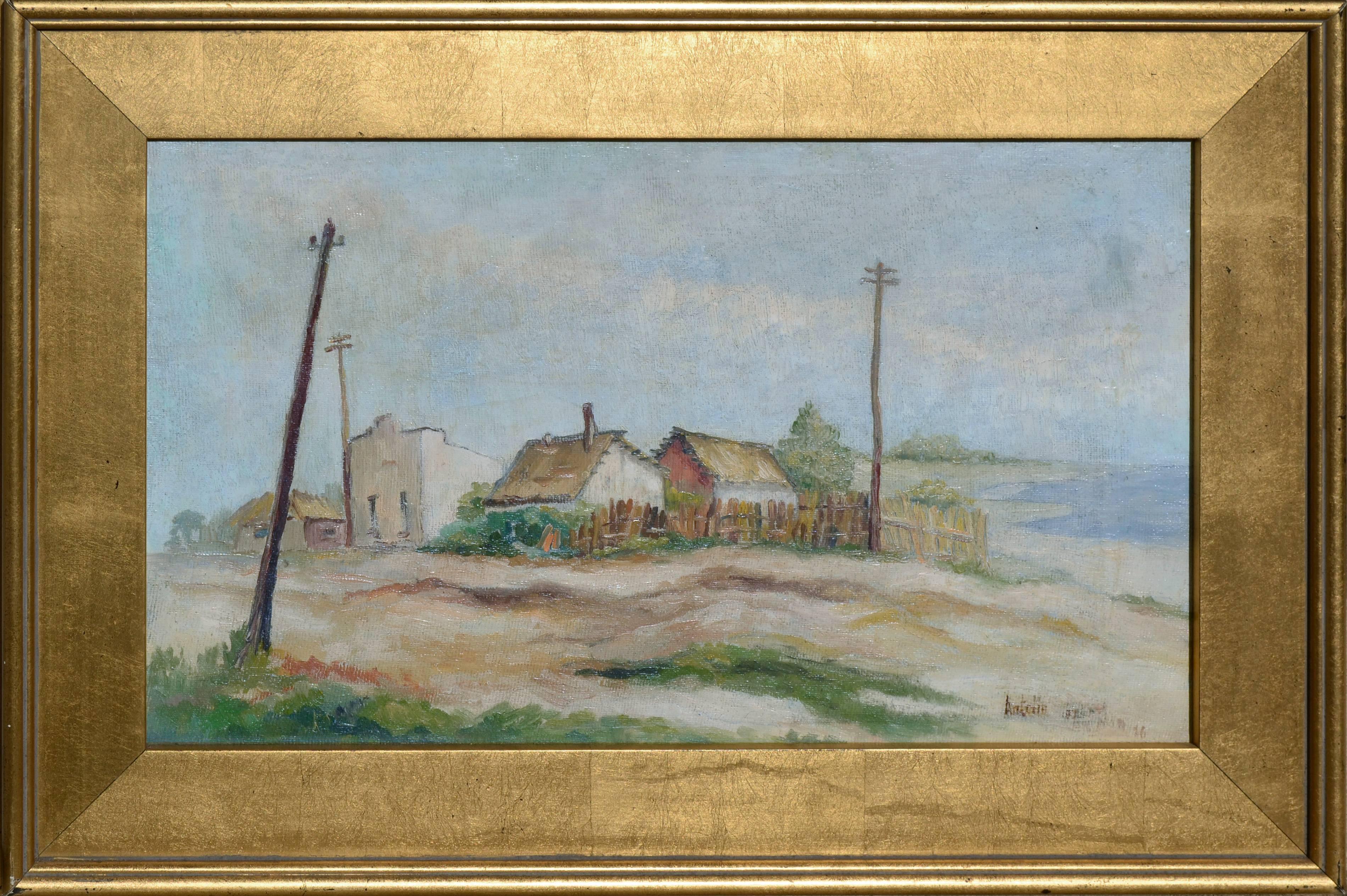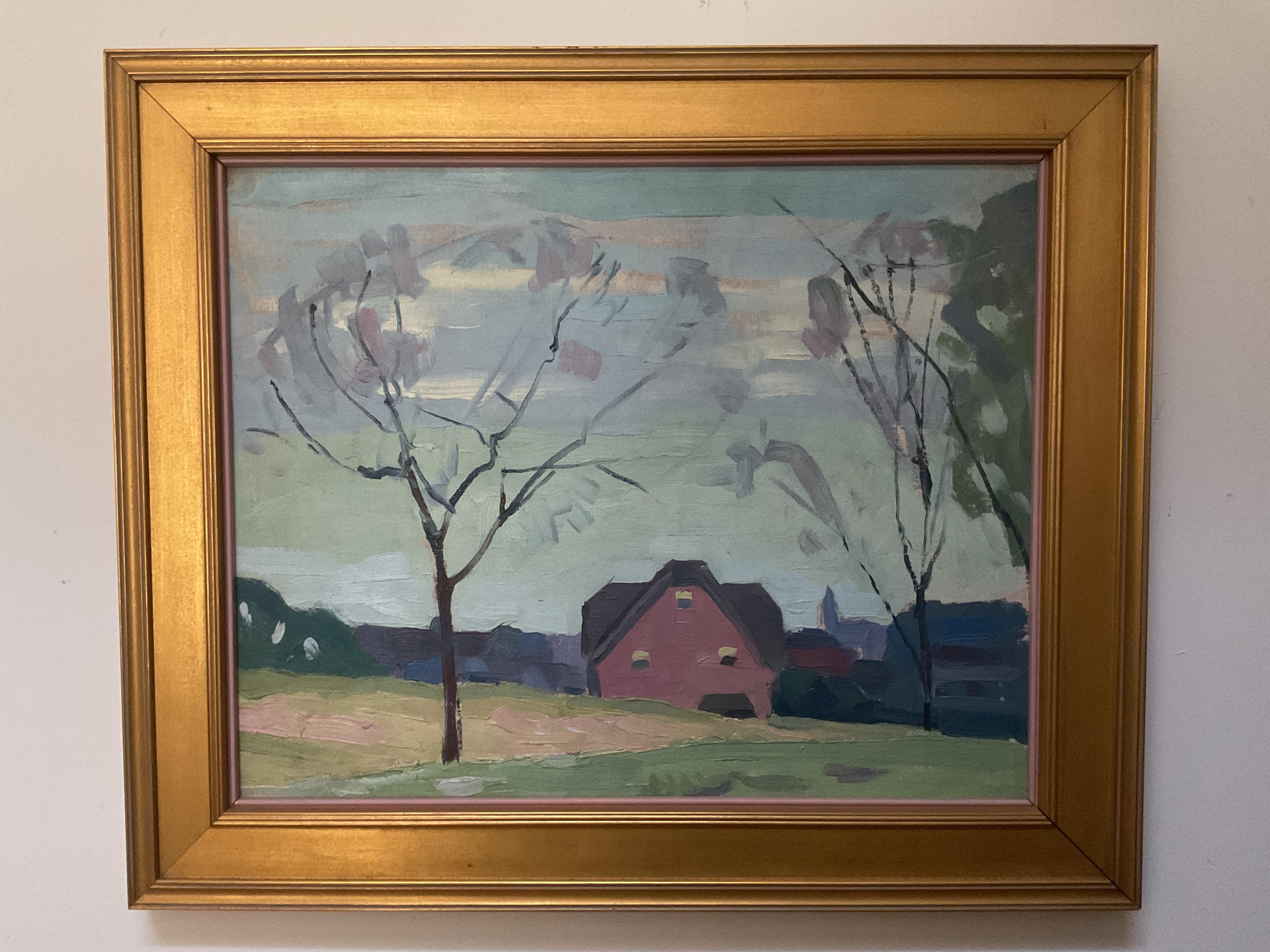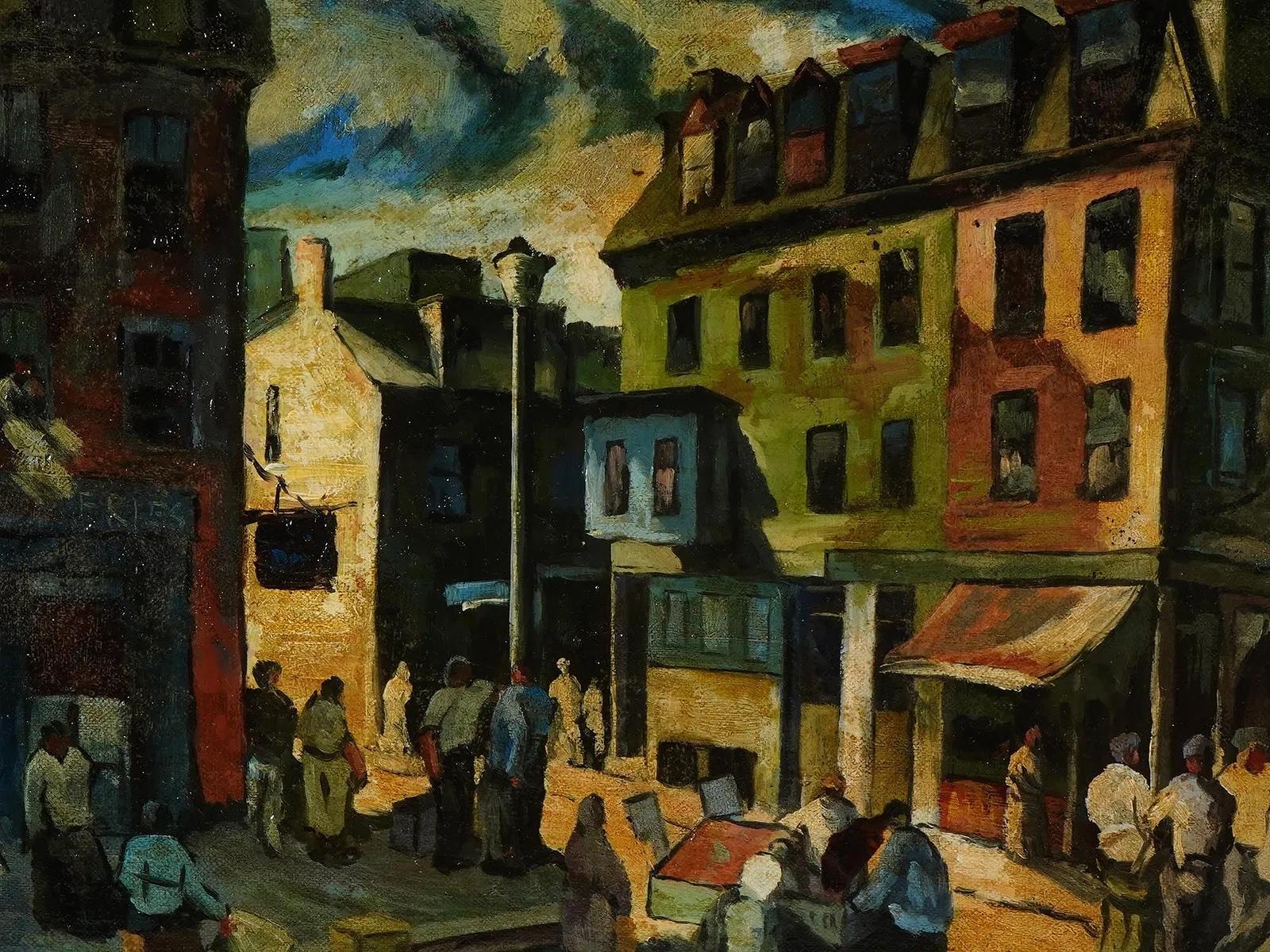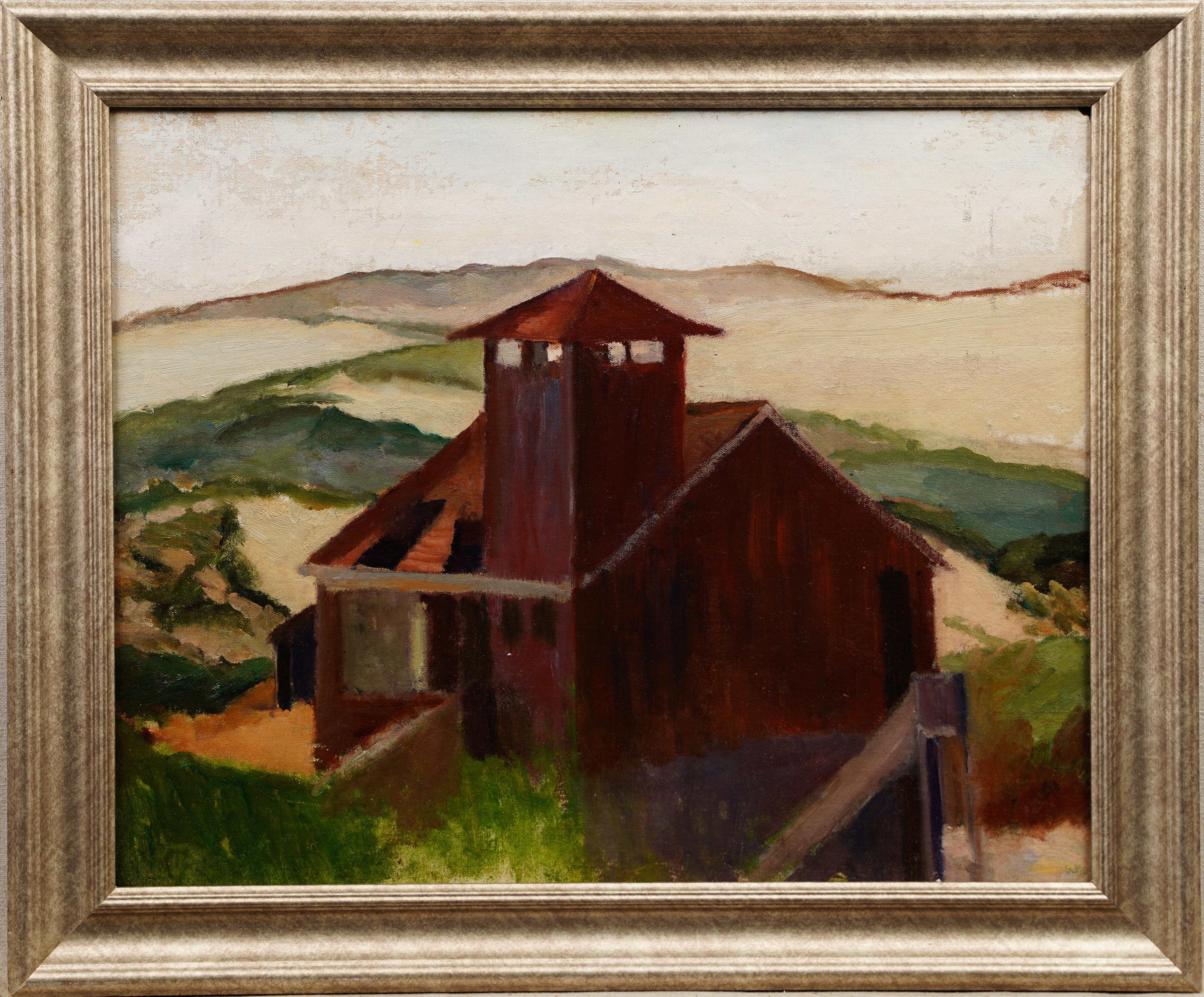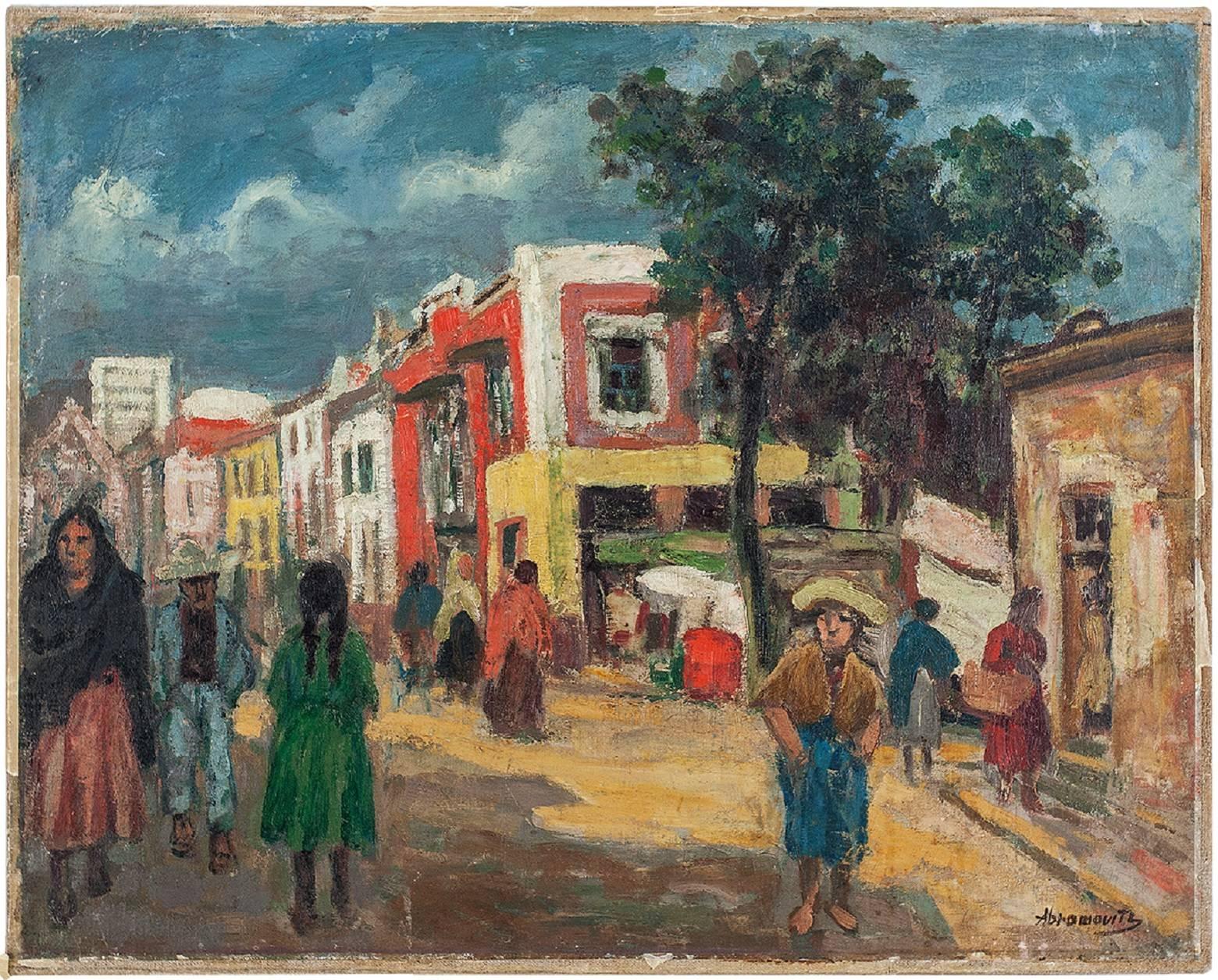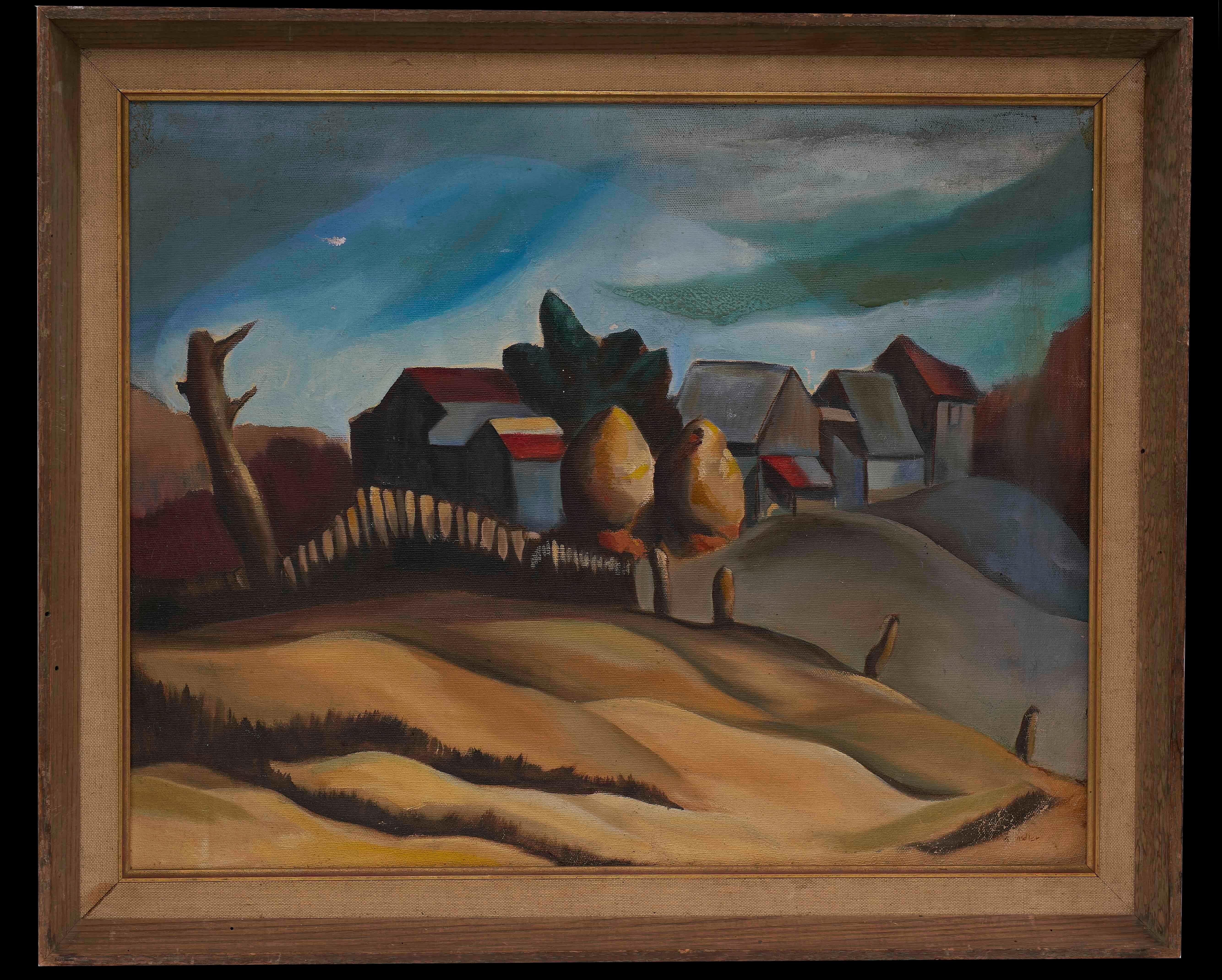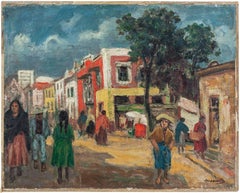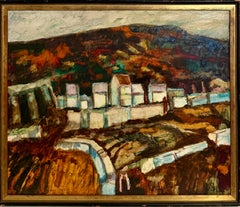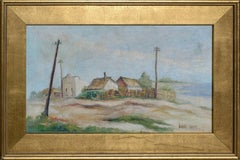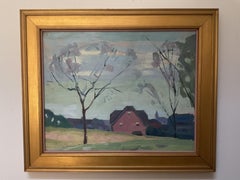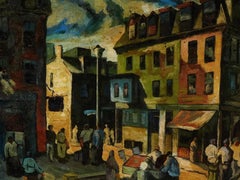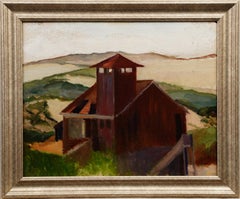Items Similar to WPA Period "Coastal Village" American Modernist Realism Oil Painting Lev Landau
Want more images or videos?
Request additional images or videos from the seller
1 of 9
Samuel David Lev-LandauWPA Period "Coastal Village" American Modernist Realism Oil Painting Lev Landau
$2,600
£1,973.88
€2,257.69
CA$3,632.58
A$4,040.22
CHF 2,109.68
MX$49,165.16
NOK 26,943.79
SEK 25,268.52
DKK 16,850.03
Shipping
Retrieving quote...The 1stDibs Promise:
Authenticity Guarantee,
Money-Back Guarantee,
24-Hour Cancellation
About the Item
Signed and titled with Yiddish inscription verso.
9 X 12 inches board size. beng sold unframed.
Painter, New York, N.Y. Samuel David Lev-Landau was born in Warsaw, Poland and emigrated to the United States. Trained at the Graphic Sketch Club, Philadelphia and studied with Sol Wilson and Phil Reisman. Worked primarily in oil and casein.
There were a number of well known jewish artists included in the WPA FSA New Deal programs including Ben Shahn, William Gropper, Ben Zion, Abraham Rattner, Raphael and Moses Soyer and many more.
Collections: Butler Institute of American Art
Norfolk Museum of Arts and Sciences (VA) Tel Aviv Museum of Art
Exhibitions: Corcoran Gallery of Art (Washington, DC) biennial, 1951 Pennsylvania Academy of the Fine Arts annual, 1951
National Academy of Design (New York), 1951, 1952, 1953 and 1956
- Creator:Samuel David Lev-Landau (1895 - 1979, American, Polish)
- Dimensions:Height: 14.5 in (36.83 cm)Width: 17.5 in (44.45 cm)
- Medium:
- Movement & Style:
- Period:
- Condition:Measurements include frame needs to be reframed, minor wear. being sold unframed.
- Gallery Location:Surfside, FL
- Reference Number:1stDibs: LU38213044982
About the Seller
4.9
Platinum Seller
Premium sellers with a 4.7+ rating and 24-hour response times
Established in 1995
1stDibs seller since 2014
1,784 sales on 1stDibs
Typical response time: <1 hour
- ShippingRetrieving quote...Shipping from: Surfside, FL
- Return Policy
Authenticity Guarantee
In the unlikely event there’s an issue with an item’s authenticity, contact us within 1 year for a full refund. DetailsMoney-Back Guarantee
If your item is not as described, is damaged in transit, or does not arrive, contact us within 7 days for a full refund. Details24-Hour Cancellation
You have a 24-hour grace period in which to reconsider your purchase, with no questions asked.Vetted Professional Sellers
Our world-class sellers must adhere to strict standards for service and quality, maintaining the integrity of our listings.Price-Match Guarantee
If you find that a seller listed the same item for a lower price elsewhere, we’ll match it.Trusted Global Delivery
Our best-in-class carrier network provides specialized shipping options worldwide, including custom delivery.More From This Seller
View AllStreet Scene Oil Painting Circa 1930s
By Albert Abramovitz
Located in Surfside, FL
Albert Abramovitz (1879-1963), born in Riga, Latvia, on January 24, 1879. He studied art at the Imperial Art School in Odessa and at the Grande Chaumière in Paris. In Paris, he becam...
Category
Early 20th Century American Impressionist Figurative Paintings
Materials
Canvas, Oil
LAKEWOOD N.J., 1936 Modernist Oil Painting, Judaica
By Emanuel Glicenstein Romano
Located in Surfside, FL
Genre: Modern
Subject: Landscape
Medium: Oil
Surface: Board
Country: United States
Dimensions: 30" x 22"
EMANUEL ROMANO
Rome, Italy, b. 1897, d. 1984
Emanuel Glicenstein Romano was born in Rome, September 23, 1897.
His father Henryk Glicenstein was a sculptor and was living in Rome with his wife Helena (born Hirszenberg) when Emanuel was born. His father obtained Italian citizenship and adopted the name Enrico. Emanuel was brought up in Italy, Switzerland, Germany, England and Poland.
In 1926 Emanuel and his father sailed for New York. They briefly visited Chicago. Romano's sister, Beatrice, and mother only joined them in New York years later.
Romano changed his name on his arrival to America and some have erroneously speculated that this was to avoid antisemitic discrimination. In truth, as the son of a highly-regarded artist, Romano changed his name to ensure that any success or recognition he would later attain, would be the result of nothing other than his own merit as an artist, and not on account of his father's fame.
In 1936 Romano was worked for the Federal Art Project creating murals. During and immediately after World War II, Romano created a series of allegorical works depicting graphic holocaust images that were held closely by the family until after his passing. One of these works is now on permanent display in the Florida Holocaust Museum in St. Petersburg Florida.
Emanuel's father died in 1942 in a car accident before they could realize their shared dream of visiting Israel.
In 1944 Romano, having completed his degree at the Pennsylvania Academy of Fine Arts and the Art Institute of Chicago, began teaching at the City College of New York.
Romano moved to Safed, Israel in 1953 and established an art museum in his father's memory, the Glicentein Museum.
COLLECTIONS
Indianapolis Museum of Art
Metropolitan Museum of Art
Boston Fine Arts Museum
Fogg Museum
Musée Nacional de France
Recently his work has been added to the Florida Holocaust Museum collection. His notable works include his holocaust themed allegorical paintings as well as portraits of Marianne Moore, his father and William Carlos...
Category
1930s American Modern Figurative Paintings
Materials
Oil, Board
Social Realist Street Scene Modernist Landscape Oil Painting
By Paul Zimmerman
Located in Surfside, FL
Oil Painting Mid 20th century, signed P. Zimmerman Reminiscent of the Mid Century Social Realist and WPA works of Ben Shahn this captures an architectural street scape...
Category
Mid-20th Century American Modern Landscape Paintings
Materials
Oil
Modernist Oil Painting Donald Roy Purdy Village on a Hillside Fauvist Colors
By Donald Roy Purdy
Located in Surfside, FL
Donald Roy Purdy (1925 - 2016 Ct.).
Framed oil on board
'Belgian Village'
Hand signed lower right, (signed twice) labeled verso.
Genre: Modern
Subject: Landscape
Medium: Oil
Surfa...
Category
20th Century Fauvist Figurative Paintings
Materials
Oil, Board
Charles Chartier 1951 French Cubist Modernist Oil Painting Surreal Paris Village
Located in Surfside, FL
Alex Charles Chartier, French, 1894-1957
Oil painting on board
1951
Quartier Plaisance, Paris village scene
Hand signed and dated '51 lower left.
Dimensions: 21" x 25-3/4", frame...
Category
Mid-20th Century Modern Landscape Paintings
Materials
Oil, Board
French Modernist Mid Century Abstract Village Landscape Oil Painting
By Henri d'Anty
Located in Surfside, FL
Signed lower right, "d'Anty", a fine and early impression in excellent condition.
A noted member of the second generation of the School of Paris, Henri d'Anty won the Prix Cezanne in 1959 and the Prix Populiste in 1973. He is listed in all relevant art reference works including Benezit which gives a signature sample. We are pleased to offer a vibrant graphic work by this French Post-Impressionist...
Category
20th Century Post-Impressionist Landscape Paintings
Materials
Oil
You May Also Like
Mid Century California Coastal Town Landscape
Located in Soquel, CA
Quaint mid-century landscape of a small California town, by unknown artist Antolin (American, 20th Century). Signed "Antolin" lower right. Painted on artist's board laid down on blac...
Category
1950s American Impressionist Landscape Paintings
Materials
Canvas, Oil, Cardboard
American Modernist Town Scene Painting by Pennsylvania artist Joseph M. Plavcan
Located in Baltimore, MD
This colorful late spring scene is most likely around Erie, Pennsylvania. Artist and teacher Joseph M. Plavcan generally painted around the area in which he lived for over 50 years.
Joseph Michael Plavcan was born near Pittsburg, in Braddock. He attended the Pennsylvania Academy in 1926, studying with renowned New Hope artist Daniel Garber. Through a scholarship, he went to Europe to study. He returned to Erie in 1932 and became an art instructor, teaching for the next 38 years. Plavcan went far beyond teaching trade school requirements and instilled a true sense of sophisticated artistry in his students. During his artistic career, he exhibited often in Philadelphia, Washington, New York and Chicago.
This painting, oil on canvas, demonstrates Plavcan’s style, utilizing figurative abstraction with a modernist color palette. The paint is not over applied and areas are treated with smooth broad brush strokes. The hint of late blooming leaves are dashes of paint applied in a fast yet confident manner. Plavcan’s sense of light, demonstrated in the distant church tower is spot on.
While not signed, there are two official estate stamps on the reverse that attest to the authenticity of Plavcan’s work. The piece measures 16” x 20” and appears to be canvas applied to a back board. This was likely done by the former retailer, Hudson House Galleries in Hagerstown, Maryland. That shop was a fine regional art gallery and antiques shop for decades until its closure about five years ago. The painting is nicely framed in a modernist gold wood frame with a subtle pink liner. The overall framed dimensions are about 20” x 24”. The painting is in very good condition, bright and crisp. There is a very minor vertical crease above the peak of the house that is truly barely noticeable from any distance. Other than that, all is fine with the work and its frame.
This strong, colorful work by Joseph Plavcan...
Category
1960s American Modern Landscape Paintings
Materials
Oil
Cityscape Mid-20th Century Modern Social Realism American Scene Regionalism WPA
Located in New York, NY
Cityscape Mid-20th Century Modern Social Realism American Scene Regionalism WPA
Samuel Thal (1903 to 1964)
"Cityscene"
12 x 16 inches
Oil on board, c. 1940s
Signed verso
Framed: 19...
Category
1940s American Modern Figurative Paintings
Materials
Board, Oil
Antique American Framed Beach Scene Modernist New England Oil Painting
Located in Buffalo, NY
Antique American modernist beach scene oil painting. Oil on board. Framed. Image size, 20L x 16H.
Category
1950s Modern Abstract Paintings
Materials
Canvas, Oil
$1,036 Sale Price
20% Off
American Regionalist Landscape Painting by Very Talented Mystery Artist Signed
Located in San Francisco, CA
American Regionalist Landscape Painting by Very Talented Mystery Artist
Signed Lower Right
Early 20th century
In good vintage condition with areas of paint loss
Oil on Canvas
...
Category
20th Century Landscape Paintings
Materials
Canvas, Oil
Laura Hoernig New Mexico Landscape with Houses and Figures Oil Painting c.1930s
Located in San Francisco, CA
Laura Hoernig New Mexico Landscape with Houses and Figures Original Oil Painting c.1930s
Original oil on canvas
Dimensions 20" wide x 16" high
The distressed frame measures 22.5" wide x 18.5" high
Unsigned / Undated
The frame is included in "as is" condition
The canvas has been stretched over a newer stretcher (as found)
The painting is in good vintage condition. The upper left shows some possible over-painting. Please see all images. This is a rare painting by this talented artist. A great find!
Laura Hoernig was born in Kansas City, Missouri in 1872. She lived at 22 West 58th Street in Kansas City during the 1920's.
Hoernig studied and sometimes traveled with artist George Sass...
Category
Early 20th Century Impressionist Landscape Paintings
Materials
Canvas, Oil
More Ways To Browse
Artist Painting Landscape Wpa
David Samuels
Soyer Moses
Ben Shahn Signed
Landau Vintage
Butler And Wilson
Vintage Butler And Wilson
David Reisman
W S George
Hudson River School Oil Paintings
J M B
Old French Board Painting
Parisian Street Painting
Vintage Oil Can
Arizona Landscape Oil Painting
Landscape Painting Indiana
1930s Beach
Bath House
